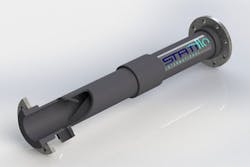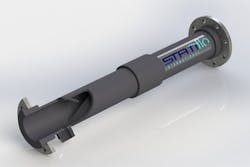A new non-ragging static pipe mixer uses a series of static elements, with dynamic flow simulation to avoid leading edges where fibrous material would otherwise attach and build up.
By Gareth Fry
Challenges facing wastewater treatment plants include the efficient removal of phosphorous, accurate polymer dosing for sludge preconditioning and reducing the amount of chemicals required in other wastewater dosing applications. Any dosing application relies on effective mixing. All too often this has been achieved by dosing at a point in the channel or pipe where the greatest amount of turbulence has been observed.
Static mixers are available either in open channel or pipe variants. However, one problem with using static mixers is that ragging or blocking can quickly arise in wastewater applications, creating unacceptable maintenance overheads.
It’s common that the piping section has to be removed and manually cleared, adding significantly to maintenance costs and of course process downtime.
Meanwhile, non-ragging/blocking static pipe mixers offer a potential solution to wastewater plants plagued by ragging/blocking problems. They are designed to avoid a build-up of fibres on the mixer elements.
The non-ragging (NR) static pipe mixer uses a series of static elements. Dynamic flow simulation has been used in the unit’s design to avoid leading edges where fibrous material would otherwise attach and build up.
The positioning of the elements in the mixer is critical as their placement forces fluid from the outside of the pipe to the centre of the device, creating a more rotational mixing effect rather than the traditional radial mixing and flow division generated that is generated by traditional clean water static mixers.
Further down the mixer housing more elements repeatedly reverse the flow rotation to ensure highly effective chemical mixing, which enables reduction in the amount of chemicals used.
As well as having nowhere for fibres to attach to the elements, the mixer design also provides clear space for any obstructive materials to pass easily through the mixer while they are being rotated and mixed.
One of Europe’s largest water companies placed the Statiflo NR static pipe mixer on trial, commenting: “The effective mixing of polymers is important to the industry as it can produce an operational saving by reducing the amount of polymer used, but only if the pipe remains free flowing. If a blockage occurs, then those savings are immediately dissipated due to the maintenance costs of gaining access to the unit and the manual removal of the material blocking the pipe.
“As a result of the trial we have installed a number static pipe mixers. To date these have provided trouble free performance and we believe have resulted in an important reduction in polymer usage.”
Gareth Fry is managing director of Statiflo.
More Water & WasteWater International Archives Issue Articles




